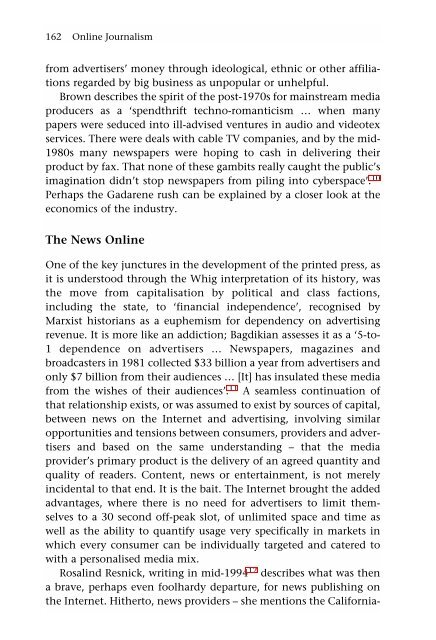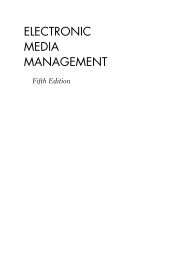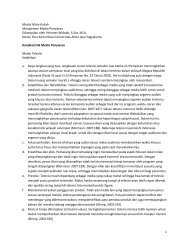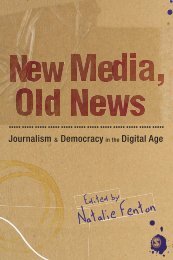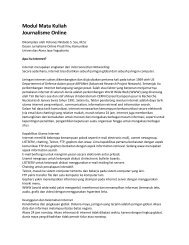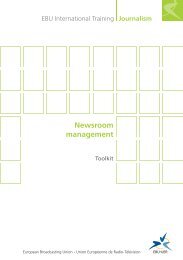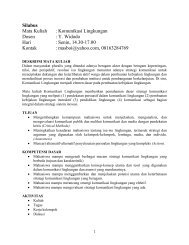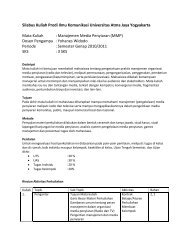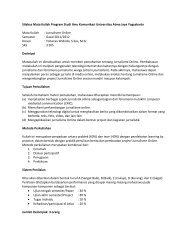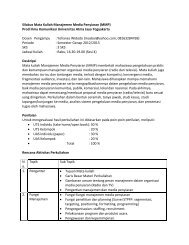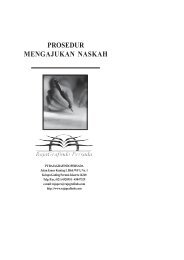Online Journalism - Ayo Menulis FISIP UAJY
Online Journalism - Ayo Menulis FISIP UAJY
Online Journalism - Ayo Menulis FISIP UAJY
You also want an ePaper? Increase the reach of your titles
YUMPU automatically turns print PDFs into web optimized ePapers that Google loves.
162 <strong>Online</strong> <strong>Journalism</strong><br />
from advertisers’ money through ideological, ethnic or other affiliations<br />
regarded by big business as unpopular or unhelpful.<br />
Brown describes the spirit of the post-1970s for mainstream media<br />
producers as a ‘spendthrift techno-romanticism … when many<br />
papers were seduced into ill-advised ventures in audio and videotex<br />
services. There were deals with cable TV companies, and by the mid-<br />
1980s many newspapers were hoping to cash in delivering their<br />
product by fax. That none of these gambits really caught the public’s<br />
imagination didn’t stop newspapers from piling into cyberspace’. 10<br />
Perhaps the Gadarene rush can be explained by a closer look at the<br />
economics of the industry.<br />
The News <strong>Online</strong><br />
One of the key junctures in the development of the printed press, as<br />
it is understood through the Whig interpretation of its history, was<br />
the move from capitalisation by political and class factions,<br />
including the state, to ‘financial independence’, recognised by<br />
Marxist historians as a euphemism for dependency on advertising<br />
revenue. It is more like an addiction; Bagdikian assesses it as a ‘5-to-<br />
1 dependence on advertisers … Newspapers, magazines and<br />
broadcasters in 1981 collected $33 billion a year from advertisers and<br />
only $7 billion from their audiences … [It] has insulated these media<br />
from the wishes of their audiences’. 11 A seamless continuation of<br />
that relationship exists, or was assumed to exist by sources of capital,<br />
between news on the Internet and advertising, involving similar<br />
opportunities and tensions between consumers, providers and advertisers<br />
and based on the same understanding – that the media<br />
provider’s primary product is the delivery of an agreed quantity and<br />
quality of readers. Content, news or entertainment, is not merely<br />
incidental to that end. It is the bait. The Internet brought the added<br />
advantages, where there is no need for advertisers to limit themselves<br />
to a 30 second off-peak slot, of unlimited space and time as<br />
well as the ability to quantify usage very specifically in markets in<br />
which every consumer can be individually targeted and catered to<br />
with a personalised media mix.<br />
Rosalind Resnick, writing in mid-1994 12 describes what was then<br />
a brave, perhaps even foolhardy departure, for news publishing on<br />
the Internet. Hitherto, news providers – she mentions the California-


